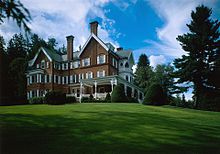George Perkins Marsh Boyhood Home
The George Perkins Marsh Boyhood Home , also known as Marsh-Billings House , is the architectural hub of the Marsh-Billings-Rockefeller National Historical Park , on Vermont Route 12 in Woodstock , Vermont . The building, which was built in 1805 and enlarged several times, is historically significant as George Perkins Marsh , a pioneer of nature conservation , spent his childhood here. Later in the 19th century it was inhabited by businessman Frederick H. Billings , a co-founder of the Northern Pacific Railroad . Architecturally, it is also significant as a high quality example of the Queen Anne style . The changes and additions were commissioned by Billings and designed by Henry Hudson Holley . The home and garden were designated a National Historic Landmark in 1967 .
The 220 acre property was donated to the people of the United States in 1992 by Mary French Rockefeller (a granddaughter of Frederick Billings) and Laurance Rockefeller .
history
Charles Marsh , a prominent lawyer in Vermont , had the core of the current building built in 1805 as a typical two-story house in the "Federal style" with five bay windows for his family. His son, George Perkins Marsh, was born in another house in Woodstock in 1801 and grew up in the house until he left for Dartmouth College at the age of 16 . Like his father, George became a lawyer and politician. It was founded in 1834 Congressman of the Whigs and the president John Tyler and Abraham Lincoln appointed to diplomatic posts. Between the 1830s and 1860s, he developed a philosophy of land management that laid the foundation for the environmental movement in the United States. In 1864 he published Man and Nature, or the Physical Geography as Modified by Human Behavior . This work, updated in 1874, gave a historical outline of the decline of earlier societies due to a lack of resource-efficient management. It called for activities to protect the environment. Marsh died in 1882 from the wider implementation of his ideas.
The then 100 hectare property was bought by Frederick H. Billings in 1869. The Royalton lawyer had made a fortune selling real estate during the California gold rush . He was one of the founders of the Northern Pacific Railroad and was its president from 1873 to 1881. Between 1869 and 1881 Billings commissioned two extensive extensions and renovations of the house. First a wing and the mansard roof were added. The house was later fundamentally redesigned in the Queen Anne style based on designs by Henry Hudson Holley . Billings set up a model farm on his property. The farm outside the national park is managed as a "living history museum". Billings had 23 km of driveways laid out in the higher part of the property.
The house and 16 acres of land were granted National Historic Landmark status on June 11, 1967 and were listed as a structure on the National Register of Historic Places because of their connection to Marsh and Billings . Later owners were Mary French Rockefeller (Billings' granddaughter) and her husband Laurance Rockefeller. The influential environmental adviser to several US presidents donated the house and the higher part of the property to the people of the United States in 1992. In August of that year, the Marsh-Billings-Rockefeller National Historical Park was established. The George Perkins Marsh Boyhood Home is a Contributing Property of this Historic District .
The house is open for guided tours between May and October.
See also
Individual evidence
-
^ A b George Perkins Marsh Boyhood Home . In: National Historic Landmark summary listing . National Park Service. Archived from the original on December 22, 2008. Info: The archive link was automatically inserted and has not yet been checked. Please check the original and archive link according to the instructions and then remove this notice. Retrieved February 19, 2008. Listing of National Historic Landmarks by State: Vermont. National Park Service , accessed February 24, 2020. Marsh, George Perkins, Boyhood Home on the National Register of Historic Places , accessed February 24, 2020.
- ^ A b c Polly M. Rettig, John D. McDermott: National Register of Historic Places Inventory-Nomination: Marsh-Billings House / George Perkins Marsh Boyhood Home . (pdf) In: National Park Service (Ed.): NATIONAL REGISTER OF HISTORIC PLACES . May 26, 1967.
- ↑ a b c Reflections on Environmental History with a Human Face: Experiences from a New National Park . National Park Service. Retrieved March 11, 2015.
- ^ Marsh - Billings - Rockefeller National Historical Park on the National Register of Historic Places , accessed February 24, 2020.
Coordinates: 43 ° 37 ′ 49 ″ N , 72 ° 31 ′ 5 ″ W.
